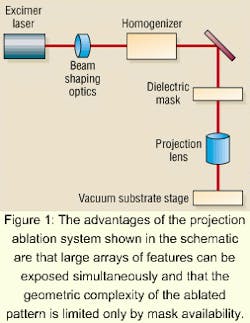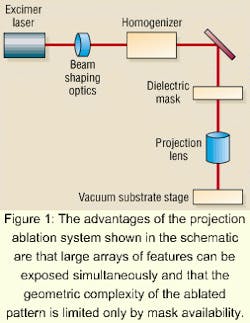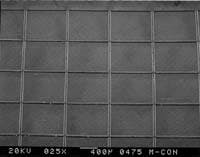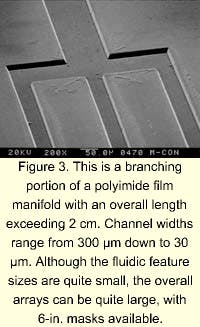Excimer lasers target material ablation
Marvin Kilgo
As excimer lasers have matured from laboratory tools to increasing industrial use, manufacturing processes have developed to take advantage of the unique properties of this family of lasers. Among the most widely known applications is the production of inkjet-printer nozzles, which is a commercially important example of the creation of microscale fluidic devices.
This family of products includes drug-delivery systems, microscale heatpipes and heat exchangers, chemical-reactor networks, and chemical-analysis tools. Precise control of small quantities of fluid is important for all of these devices, and, depending on the working fluid and desired flow rates, length scales ranging from less than 1 µm to more than 100 µm may be needed.
The manufacture of these devices requires an understanding of the nature of excimer machining processes. This article discusses process development issues that often arise with excimer projection ablation, particularly for polymeric substrates.
Exploring the process
Excimer micromachining processes typically use ablation technology to remove material from the substrate. Ablation occurs when the laser beam's intensity passes a threshold value that depends on the material to be ablated and the wavelength of the laser (see table).
The importance of creating fine features by ablation becomes obvious when the undesired thermal effects of operating at low fluence are considered. At intensities below the ablation threshold, the absorbed energy heats the substrate, which results in numerous thermal processes. As the substrate temperature rises, the material may begin to oxidize or decompose. Ultimately, a phase-transition temperature may be reached, and the material will begin to melt or boil. In these cases, the absorbed radiation acts as an internal heat source. As a result, the temperature profiles in the material can be predicted with good accuracy. Often, these temperature profiles produce extensive damage in the heat-affected zone surrounding the irradiated region.
In contrast, ablation is often referred to as a "nonthermal process" because the removal of material is caused by direct bond breaking as energy is absorbed and not by rapid heating and vaporization of the material. Furthermore, because ablation depths per pulse are often greater than the optical absorption depth and the pulse length is very short compared to thermal diffusion time scales, the amount of residual energy left in the substrate is typically relatively small. Temperature increases in the bulk material are therefore much reduced by comparison with nonablative laser processes.
Ablative processes are attractive for making features with length scales on the order of 1 to 100 µm because of the potential for increased material removal rates and minimized heat affected zones. To take advantage of this process window requires selection of an appropriate laser and development of optical and material-handling subsystems that provide sufficient resolution and alignment capabilities.
Excimer lasers have several features that make them useful in commercial ablation tools. First, because of their short pulse lengths, high intensities are possible with modest pulse energies. Also high ablation rates can be obtained because many polymers have very short absorption depths in the ultraviolet region where excimers operate. Perhaps most important, however, the relatively low spatial coherence of the beam allows the use of projection optics, which dramatically increases the throughput in the case of large arrays of features.
In a projection ablation tool, the beam is conditioned to achieve a uniform energy distribution at the object plane. A mask is placed in this plane, and the image of the mask is then relayed through a projection lens onto the substrate which is in the image plane (see Figure 1). The intensity at the substrate may be increased by demagnification through the projection lens to achieve extremely high fluences. Nevertheless, since this results in a reduction of the image area, in practice, demagnification is typically modest.
Figure 2: A scanning projection tool ablates a network of crossed 60-µm channels into a polyimide film (top). An image of an array of cells is the reverse of this pattern (bottom).
The advantage of the projection system is that large arrays of features can be exposed simultaneously. In addition, the geometric complexity of the ablated pattern is limited only by mask availability. Additionally, alignment typically only is performed once for an array. This operating scheme contrasts with focusing systems that can achieve very high fluences, but must generate features sequentially.
A particularly useful approach to projection ablation is to jointly align the mask and substrate and scan them in tandem past a 1:1 projection lens. Generally, such tools operate at a laser frequency in excess of 200 Hz, and the mask and substrate are translated at constant velocity past the lens. Careful selection of the illuminated region eliminates the potential for stitching problems where images overlap.
For such a system, an arbitrarily large pattern can be generated, with constraints imposed only by material handling capabilities. This useful process makes the generation of large collections of very small features quite straightforward (see Figures 2 and 3).
The development of ablation processes relies on both theory and experimental results. Ablation characteristics are primarily controlled by the laser wavelength, laser pulse frequency, and fluence at the target. Further considerations in tool operation include material handling and alignment and the operation of a debris removal system. By carefully adjusting these parameters, it is possible to define a process window that controls the ablation rate per pulse, the wall angle of the ablated opening, the extent of debris deposition around the ablation site, and the magnitude of the heat affected zone.
Mask features must be accurately and precisely defined because the mask defines the image that will be ablated. A variety of mask coatings may be used, depending on the anticipated fluence (energy density) at the mask. Successful ablation masks have been developed using metallic coating, such as chrome or aluminum, and using reflective dielectric coatings. The dielectric masks can handle greater fluences, and are often preferred for that reason.
Developing an economically viable ablation process for manufacturing microfluidic devices therefore requires a careful balancing of desired product characteristics and process throughput. Excimer ablation already plays a pivotal role in the manufacturing of microfluidic devices, and that position will certainly become stronger as newer, more-complex products move into the marketplace.
Marvin Kilgo is a senior research scientist for Tamarack Scientific Co., (P) 714-238-7000 or e-mail: [email protected].




